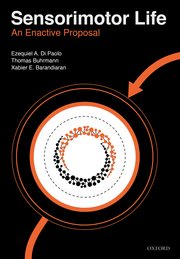Friday, 27 July 2018
Two Books on the Enactive Approach in Cognitive Science

This week, I’d like to tell you about two books on the philosophy of cognitive science. Both of them were published in 2017, and both of them deal with the enactive approach first proposed in the 1990s by pioneers such as Francisco Varela and Evan Thompson. Since then, the enactive approach has become a major research topic in contemporary cognitive science, so it is no surprise that entire books are now devoted to it.
The first of these two books is Sensorimotor Life: An Enactive Proposal, by Ezequiel Di Paolo, Thomas Buhrmann and Xabier E. Barandiaran. Di Paolo helped to refine the concept of autopoiesis proposed by Varela and Humberto Maturana in the 1970s, an operational definition of life at the centre of a certain way of seeing embodied cognition (as, for example, in the thesis of the continuity between life and cognition defended by Evan Thompson in his book Mind in Life). This book is intended both for students and for researchers and offers what seem to be very broad considerations about embodied cognition and emotions, as we experience them at every moment in our everyday lives.
The other book, by Daniel Hutto and Erik Myin, is Evolving Enactivism. Basic Minds Meet Content. This book seems to be aimed more at the community of cognitive science researchers, and in particular those who investigate the philosophy of mind. Hutto and Myin are part of the radical interpretive school of enactivism, meaning that they defend the idea that some forms of cognition can exist without being associated with any semantic content (derived from the common, public forms of our representations in language). As you can see, these philosophical debates quickly get into technical details that can become very thorny and pretty abstract.
That is also the case for the following review of this book, written by Evan Thompson and published on the academic website Philosophical Reviews. Thompson can be very clear in his books, even when he is writing about complex subjects. But I have to admit that his rather negative assessment of Hutto and Myin’s book may be fairly opaque to the general public. The following excerpt does, however, provide a very good summary of the enactive approach.
The enactive approach is a cognitive science research program based on two interconnected pillars (see Varela et al. 1991; Thompson 2007; Di Paolo et al. 2017). One pillar is the rejection of the representational theory of mind, the emphasis on the dynamics of agent-environment sensorimotor coupling, and the thesis that embodied interaction is constitutive of cognition. The other pillar is the concept of biological autonomy. The basic idea is that living beings generate and maintain themselves. Stated more abstractly, an autonomous system is a self-generating and self-sustaining system. The theory of autonomous systems takes living systems as the paradigm and focuses on explaining the emergence and constitution of individuality, agency, and functional and behavioral norms. The theory of agent-environment coupling focuses on explaining cognition. For an account to be “enactive” in the full and precise sense of the term, it must include both theoretical projects. In contrast, both ecological dynamics and the sensorimotor contingency theory of perception (sometimes called “sensorimotor enactivism”) focus only on the sensorimotor coupling part of the story (and, as Hutto and Myin note, the sensorimotor contingency theory has often been presented in a representationalist way).
Body Movement and the Brain, From Thought to Language | No comments







